Intel DH57JG “Jet Geyser” - Intel's First Mini-ITX H57
by Rajinder Gill on March 1, 2010 2:00 PM EST- Posted in
- Motherboards
Performance Summary
At fixed frequencies, there’s little to divide the boards in 2D/3D application performance:
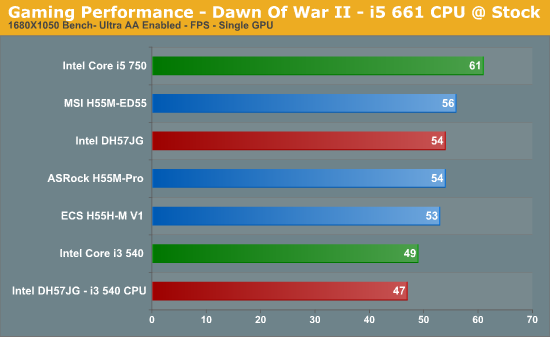

USB file transfer performance is a little slow though (we've reported this back to Intel):
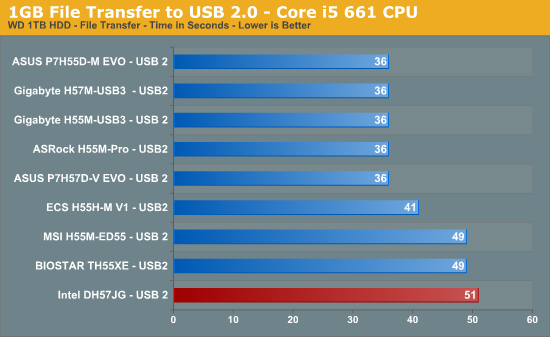
Power Consumption
Our power consumption testing utilizes the same batch of components under similar circumstances in a bid to monitor variances between idle and CPU load conditions using an AC wall meter for power consumption measurements. We install the vendor supplied power saving utilities on each board and enable power saving modes that don't involve any kind of underclocking or CPU core frequency modulation in order to run an apples to apples comparison. Assuming a maximum 150w load in the worst case scenario, actual motherboard power consumption is around 15%~20% lower than the shown figures if you factor out switching losses at the PSU.
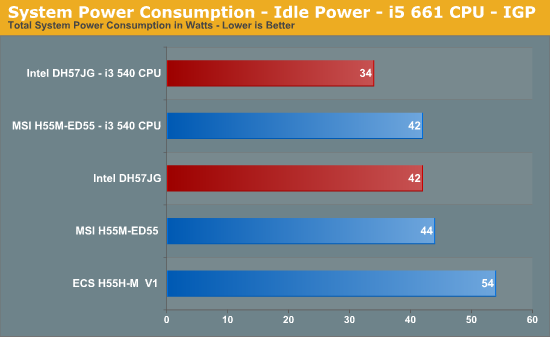
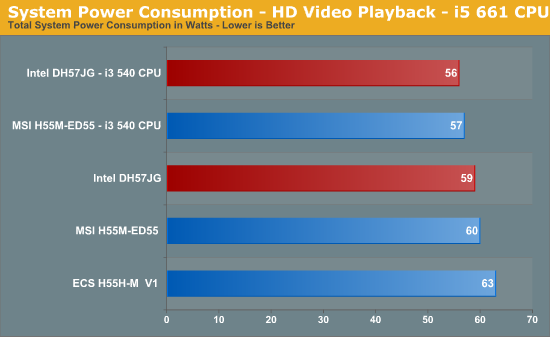
DPC Audio Latency
We’re often asked to include a DPC latency screenshot by audio enthusiasts, the DH57JG turns in a respectable performance:
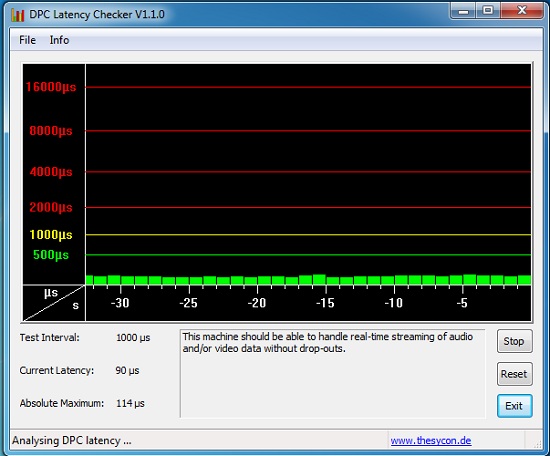
Overclocking
Like other mini-ITX motherboards, overclocking is limited by the absence of control over a key voltage rail. In this instance, Intel chose to limit processors to stock VID for CPU Vcore. The end result of this is that you’ll be limited to around 3.5GHz or so with a Clarkdale processor.
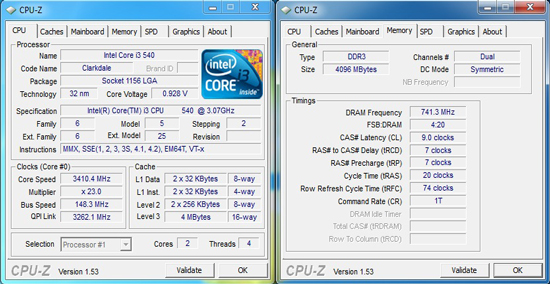
Forget about any kind of manual under-clocking on Clarkdale CPU's because you can't adjust CPU multiplier ratios on the current BIOS. SpeedStep and C-states obviously work as per Intel specification, stepping down to a 9x multiplier ratio and 0.85V core VID during light load scenarios. As a workaround for the absence of core multiplier ratio control, we suggest you change idle state power management percentages in the advanced pane of power options in Windows Control Panel - if you intend to use this board as a light load file/media server.
You can use Lynnfield processors in this board, although overclocking is limited by TDP. If you set processor core frequency higher than 3.3GHz or so, you’ll either run out of headroom due to insufficient voltage for Vcore, or the board will throttle the CPU when under load to keep current draw within the bounds of the VRM circuit.










34 Comments
View All Comments
DanNeely - Monday, March 1, 2010 - link
Aren't benchmark numbers for CPUs almost always lower than reported TDPs? Intel/etc have to design for peak theoretical power draws even if they're extremely unlikely in real life. The intel burntest utility will run your CPU hotter and draw more power than any "normal" CPU benchmarks because it's designed to run everything at the highest power load possible.deruberhanyok - Monday, March 1, 2010 - link
It would be great if you all could look into testing with less... beefy power supplies, though. I think a lot of people (myself included) would be interested to see the power draw in a more "realistic" setup.For example, Antec's ISK 300-65 with a 65W power supply, or 300-150 with a 150W power supply, are a much more likely configuration than a system with a 610W PSU (as used in the recent Zotac H55 ITX article) or a 950W PSU (as used in this article). And the difference in power supply could make for a noticeable difference in idle/load numbers.
For low-power purposes, perhaps the boards could also be tested with low power memory modules (1.35v instead of 1.5v / 1.65v) and 2.5" hard drives (as many ITX enclosures may not have space for a 3.5" hard drive).
Anyways, these are just a few suggestions that I thought would help make the information presented here more practical. Feel free to ignore them. :)
Loving these articles on ITX boards, keep 'em coming!
FATCamaro - Tuesday, March 2, 2010 - link
Yeah 600W PSU is crazy. As well there is no mention of stability or quirks versus the other H55/57 boards tested.For those looking for virtualization intel has a Q57 board with VT-d support with an i5 or i7 processor.
Rajinder Gill - Tuesday, March 2, 2010 - link
Hi,Point taken on the PSU. For a rundown of stability and quirks of the other boards used check out these articles:
http://www.anandtech.com/mb/showdoc.aspx?i=3732">http://www.anandtech.com/mb/showdoc.aspx?i=3732
http://www.anandtech.com/mb/showdoc.aspx?i=3748">http://www.anandtech.com/mb/showdoc.aspx?i=3748
later
Raja
DanNeely - Monday, March 1, 2010 - link
I'd like to second this request. PSU efficiency drops off at the low and high ends of their output ranges. Optimal levels are generally around 50% of max and while performance doesn't suffer much in the 20-80% load.If you're concerned about noise you generally want to avoid going above about 70% with normal desktop PSUs to keep the fan spinning at idle. I'm not sure if the fan noise thresholds are true of the low power models designed for mini-itx systems with onboard gfx or not.
JonnyDough - Monday, March 1, 2010 - link
I concur with your post. Realistic PSU makes a huge difference.Rajinder Gill - Monday, March 1, 2010 - link
Thanks, we're working on it...GeorgeH - Monday, March 1, 2010 - link
DH57JG, DH57G, and a DH55JG; either you’re reviewing 3 different boards or breaking a NDA. Hopefully the latter, as I’d really like to see a cheaper H55 option. ;)gtrgtgt - Sunday, March 7, 2010 - link
http://www.ccshoper.com">http://www.ccshoper.com
Rajinder Gill - Monday, March 1, 2010 - link
Sorry about that - fixed..